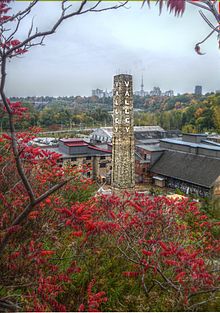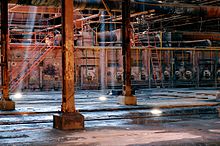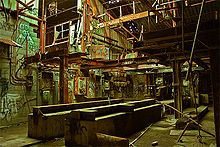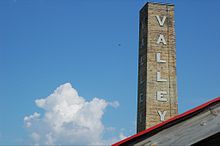- Don Valley Brick Works
-
The Don Valley Brick Works also known as Evergreen Brickworks is a former quarry and industrial site located in the Don River valley in Toronto, Ontario. Currently the buildings sit mostly unused while the quarry has been converted into a city park which includes a series of naturalized ponds. The Don Valley Brick Works operated for nearly 100 years and provided bricks used to construct many well-known Toronto landmarks, such as Casa Loma, Osgoode Hall, Massey Hall, and the Ontario Legislature. The buildings are currently undergoing restoration, courtesy of Evergreen, a national charity dedicated to restoring nature in urban environments.
Contents
History
The Don Valley Brick Works were created in 1889 by the Taylor brothers. John Taylor and his brothers, William and George, had purchased the site in the Don Valley in the 1830s where they established a paper mill. While digging post holes to make a fence, William came across some good quality clay. He took a sample to a local brick works where it was confirmed that it would make a high quality brick. A quarry was soon established at the north end of the site and a brick making plant was built at the south end of the property near the Don River.
Part of a series on the Don Valley Rivers · Don River · Castle Frank Brook · German Mills Creek · Taylor-Massey Creek Parks · Edwards Gardens · Riverdale Park History · Crothers' Woods · Don Valley Brick Works · John Taylor · Todmorden Mills Environment · Friends of the Don East · Task Force to Bring Back the Don · Toronto and Region Conservation Authority The Don Valley Pressed Brick Company produced bricks using three techniques. The first was called a soft-mud process. Clay quarried from the site was mixed with water from nearby Mud Creek, placed in moulds which were dried and then baked in kilns. A second technique called dry-press bricks used quarried shale. The shale was placed into moulds and machine pressed. A third process called stiff-mud used a mixture of clay and shale that used less water than the soft-mud process. A column of clay was forced through a die which was then cut to form using a wire. Finished product was shipped by cart out of the valley along Pottery Road or by rail on a spur built into the yard. Bricks were used mostly in Toronto but were used across the continent. The bricks made were of such good quality that they won prizes at the Chicago World's Fair in 1893 and the Toronto Industrial Fair in 1894.
In 1893, the company added a continuous down-draft kiln which increased the quality and amount of bricks produced. By 1907 the company had two of these kilns in operation and was producing between 85,000 to 100,000 bricks per day.
In 1909, the Taylors sold the company to Robert Davies (a brother-in-law). Davies changed the name to the Don Valley Brick Company Limited. In the 1920s a major expansion resulted in a name change to the Don Valley Brick Works Limited. Electricity was added and a new sand-lime plant was added that created a less expensive brick used for interior construction. In 1928, the company was sold to Strathgowan Investments and was renamed again to the Toronto Brick Company. At this time the company had reached peak production of about 25 million bricks per year.
During World War II, production was reduced. The plant used German prisoners of war that were housed at nearby Todmorden Mills. After the war a building boom revived demand. However, the sand-lime plant was destroyed by fire in 1946. Also the plant consolidated its outbuildings and three of the four signature chimneys were knocked down. Only one chimney remains today. The site underwent many changes during its existence, adding and removing buildings whenever and wherever it was condusive to the brick making process. The buildings, cluttered on the south end of the site, are all rectilinear buildings arranged in a grid-like pattern, connected wherever the users saw a need.
In 1956, United Ceramics Limited of Germany acquired the Brick Works. Over the next 25 years a new sand-lime plant was constructed. Also a Parkhill Martin Brick machine was moved from a nearby brick works to this site. It produced soft-mud bricks for the antique market. By the 1980s most of the usable clay and shale had been quarried. The company decided to offer the land to the city for $4 million CAD for conservation purposes. However, a company called Torvalley Associates offered $4,001,000 for the site and managed to purchase the site. The company had close links with East York city council and managed to convince them to rezone the land for a housing development.
The Toronto and Region Conservation Authority had final say on the matter since the site was partially on the floodplain of the valley. They expropriated the land in 1987 but were forced to pay approximately $14,000,000 since the land was zoned as residential. Another company, Brampton Brick leased the site and purchased the remaining equipment. They operated a retail outlet at the site until 1991.
In 1994, restoration of the site began. The quarry was filled in using material from the excavation of the Scotia Plaza tower in downtown Toronto. Once filled, the site was landscaped to create a series of three ponds using water diverted from Mud Creek. The water flows out of the ponds into a channel that was used to divert water into the brick plant. The channel then flows underneath Bayview Avenue and back into the Don River. The remaining area was turned into meadow. The shores of the ponds were planted with native trees, shrubs and wildflowers. The site was officially opened in 1997 and christened the Weston Quarry Gardens.
Currently, the site is being readapted by Evergreen, and environmentally conscious charity looking to make cities greener. The buildings, many of which are in disrepair, and being further restored. (see Future of the Brick Works below).
Since then, the site has attracted many species of birds and animals. Although no fish were stocked in the ponds, fish have migrated into the ponds from the Don River. The ponds have also become a dumping ground for goldfish and red-eared slider turtles that have outgrown their home terrariums.
Weston Quarry Garden
The park section of the Brick Works includes a series of three ponds, a large meadow and a small forest. The ponds are fed by a diversion pipe running from Mud Creek which flows just to the west of the Brick Works. Initially, the area adjacent to the ponds was planted with species native to Ontario. This also included some species that are not locally native including Tulip Tree, Fragrant Sumac and Eastern Redbud. These species are found only in areas along the north shore of Lake Erie. However the quarry basin of the Brick Works forms a warmer micro climate which allows these species to survive.
Once the wetlands became established, many species of birds have visited to forage or breed. Mammals, reptiles, amphibians, and some fish have also found their way to the Brick Works and have established themselves. This includes ducks, Canada Geese, toads, muskrats, sparrows, and others.
The Brick Works wetland is connected to a number of other nature reserve areas via forest trail, and is part of a larger effort to reestablish the Don Valley watershed.
This area was the site of a number of important geological discoveries which provided information on the glacial history of southern Ontario.
Future of the Brick Works
Evergreen, a Canadian non-profit organization whose activities have included stewardship of the Don Valley Brick Works site since 1997, plans to develop the abandoned buildings into a cultural centre with a focus on the environment. Evergreen will lease the "industrial pad" portion of the site from the Toronto Region and Conservation Authority to renovate several of the existing structures and construct one new building, to be called the Centre for Urban Sustainability. The goal of the scheme is adaptive reuse, where most of the buildings will be reinforced where needed and repurposed to house the new programming planned for the site. In this way, the site can be recycled as much as possible and the historical integrity of the Don Valley Brickworks can be maintained.
Evergreen Brick Works will be an education centre addressing the themes of nature, culture and community. [...] [I]t will be a destination for families and individuals to enjoy a natural refuge, while sampling a rich offering of programs and services - from gardening workshops, heritage tours, and clay-making and organic food markets, to a retail nursery, demonstration gardens and leading-edge green design techniques. [1]
$20 million of the project's $55-million dollar budget has been pledged by the federal government under the Canada Strategic Infrastructure Fund, and the Province of Ontario has contributed an additional $10 million. The construction process began in November 2008.
The project, which is still underway, is a joint venture between Du Toit Allsopp Hiller Architects, Diamond and Schmitt Architects, and several other prominent firms. DTAH is responsible for the master planning scheme, while Diamond and Schmitt are the designers of the new "Centre for Urban Sustainability", which will also function as the Welcome Centre. Other programming for the site includes an art gallery, classrooms, plant nursery, art gallery, and offices space for Evergreen and other environmental organizations. The grand opening of the Evergreen Brickworks took place September 28, 2010. The complex is now open to the public, with regular shuttle running everyday from Broadview Subway Station. Though the project is in phase II, and many buildings are still under construction, programming such as weekend farmer's markets and community yoga classes are already in place.
Restoration to the building include structural reinforcement, and replacement of material such as the current asbestos transite roofing in favour of a more effective, longer lasting material. Several of the buildings were left without roof cladding in order to create open air spaces, leaving the steel trusses visible. The building's red-brick masonry was preserved as much as possible, while interiors were renovated to update plumbing, life safety and mechanical systems, as outline in Evergreen's Master Plan Update 2007. Each building has programming set aside for it in DTAH's planning scheme, such that the project can continue to expand as funds become available. The only new building on the site, The Centre for Urban Sustainability, is currently being built, on the north-east end of the site, and Evergreen is continuing to work on merging the past and future pictures of the Don Valley Brickworks, while at the same time integrating it into the natural context which surrounds it.
See also
- Distillery District
- Doors Open Toronto
- John Taylor (paper manufacturer), the elder brother William and George Taylor
References
- "CANADA’S NEW GOVERNMENT TO PROVIDE UP TO $20 MILLION FOR EVERGREEN AT THE BRICK WORKS" (Press release). Evergreen. 2006-12-20. http://evergreen.ca/rethinkspace/?p=125. Retrieved 2007-01-05.
- Chodikoff, Ian (January 2007). Bricks and Mortar. Toronto: Canadian Architect magazine. http://www.cdnarchitect.com/issues/ISarticle.asp?id=183218&story_id=198691134637&issue=01012007.
- Hough, Stansbury, Woodland (February 1990). Don Valley Brickworks Master Plan. Toronto: Metropolitan Toronto Parks and Property Department.
- Evergreen (2007-12-05). Master Plan Update 2007 Evergreen at the Brickworks. Toronto: Evergreen.
- Metro Toronto Region and Conservation Authority (September 16, 1993). Don Valley Brickworks Regeneration Project. Toronto.
- Metropolitan Toronto Parks and Culture Deptartment (1997). Don Valley Brick Works. Toronto.
- Otto, Stephen A. (1998). Don Valley Brick Works: the company and its people: a report for East York Local Architectural Conservation Advisory Committee. Toronto.
- Unterman McPhail Cuming Associates (1994). Don Valley Brick Works: heritage documentation and analysis. Toronto.
- Evergreen Brickworks. Du Toit Allsopp Hiller Architect. http://www.dtah.com.
- Centre For Urban Sustainability. Diamond and Schmitt Architects. http://www.dsai.com.
External links
- Evergreen
- Evergreen Brick Works
- Don Valley Brick Works Park
- Location of the Brickworks, with additional photos, videos, and Web sites
Coordinates: 43°41′05″N 79°21′55″W / 43.684667°N 79.36528°W
Categories:- Brickworks
- Buildings and structures in Toronto
- Companies based in Toronto
- Don Valley
- Manufacturing plants in Canada
Wikimedia Foundation. 2010.






